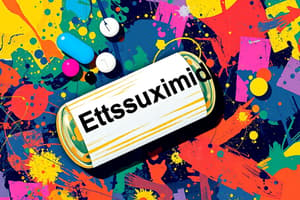Podcast
Questions and Answers
Antipsychotics are used to treat Unipolar Depression as a monotherapy.
Antipsychotics are used to treat Unipolar Depression as a monotherapy.
False (B)
Droperidol is used to produce neuroleptanesthesia.
Droperidol is used to produce neuroleptanesthesia.
True (A)
Thioridazine is used to treat Alzheimer’s Disease.
Thioridazine is used to treat Alzheimer’s Disease.
True (A)
Antipsychotics have anti-H2 activity.
Antipsychotics have anti-H2 activity.
Tardive dyskinesia is a common side effect of antipsychotic drugs.
Tardive dyskinesia is a common side effect of antipsychotic drugs.
Molindone is associated with weight gain.
Molindone is associated with weight gain.
Seizures are a common side effect of Chlorpromazine treatment.
Seizures are a common side effect of Chlorpromazine treatment.
Neuroleptic Malignant Syndrome is a common side effect of low-potency antipsychotic agents.
Neuroleptic Malignant Syndrome is a common side effect of low-potency antipsychotic agents.
Retinal deposits leading to blindness are a side effect of Chlorpromazine treatment.
Retinal deposits leading to blindness are a side effect of Chlorpromazine treatment.
Antipsychotics have anti-emetic activity.
Antipsychotics have anti-emetic activity.
Flashcards are hidden until you start studying
Study Notes
Seizures, Epilepsy, and Convulsions
- Seizures result from excessive, hypersynchronous cortical neuron activity.
- Epilepsy is a chronic disorder marked by unpredictable seizure occurrences.
- Symptomatic epilepsy arises from identifiable causes like brain injury or tumors.
- Idiopathic epilepsy has no structural abnormalities and is often genetic.
- Convulsions are involuntary muscle contractions; seizures can occur without them (e.g., petit mal).
Classification of Seizures
-
Focal Onset Seizures affect localized cortical areas:
- Focal aware (simple partial): consciousness remains intact.
- Focal impaired (complex partial): consciousness impaired.
- Focal-to-Bilateral Tonic-Clonic: starts focal, progresses to generalized tonic-clonic.
-
Generalized Onset Seizures affect both brain hemispheres:
- Generalized Tonic-Clonic (Grand mal): involves both hemispheres, often idiopathic.
- Generalized Absence (Petit mal): brief consciousness loss common in children.
- Myoclonic: sudden brief muscle contractions, seen in juvenile seizures.
- Atonic (drop seizure): sudden loss of muscle tone, common in Lennox-Gastaut syndrome.
- Epileptic spasms: infantile spasms with grimacing and head nodding.
Treatment of Epilepsy
- Oral anti-seizure medications are tailored to the patient’s seizure type.
- Single medication is preferred; adults may require multiple for hard-to-control seizures.
- Pharmacoresistant epilepsy is when seizures are inadequately controlled.
- Epilepsy surgery can resect affected brain areas, used for focal and generalized seizures and status epilepticus.
- Side effects include CNS effects (nystagmus, ataxia, diplopia) and others like gingival hyperplasia, hirsutism, osteopenia, and anemia.
Phenobarbital
- Increases GABAergic inhibition, enhancing Cl-channel opening duration.
- Metabolized in the liver and mainly excreted in urine; can induce liver enzyme changes impacting other drugs.
- Clinical use includes focal unaware, generalized tonic-clonic, and febrile seizures.
- Toxicity signs include respiratory depression; can lead to dependence and tolerance.
Antipsychotic Agents
- Schizophrenia affects 1% of the population and is marked by thinking and perceptual disturbances.
- Three main hypotheses of schizophrenia:
- Serotonin hypothesis: abnormal 5-HT2A and 5-HT2C transmission leads to hallucinations.
- Dopamine hypothesis: hyperactivity in mesolimbic dopamine affects positive symptoms.
- Glutamate hypothesis: NMDA receptor hypoactivity results in cognitive impairment.
Symptoms of Schizophrenia
- Positive Symptoms: Observable traits like delusions, hallucinations, and combativeness.
- Negative Symptoms: Unobservable traits like affective flattening, alogia, avolition, anhedonia, and attention issues.
Clinical Use of Antipsychotic Agents
- Used for acute bipolar depression, agitation in bipolar disorder, Tourette syndrome, and autism spectrum disorder.
- First-generation antipsychotics (except Thioridazine) have strong anti-emetic effects and produce sedation.
Adverse Effects of Antipsychotic Agents
- Behavioral effects: EPS (extrapyramidal symptoms), pseudodepression, tardive dyskinesia, seizures (from Chlorpromazine).
- ANS and cardiovascular effects: sedation, orthostatic hypotension, dry mouth, constipation.
- Metabolic effects: weight gain, hyperglycemia, and hyperlipidemia.
- Neuroleptic Malignant Syndrome is a serious adverse reaction to high-potency antipsychotics.
Studying That Suits You
Use AI to generate personalized quizzes and flashcards to suit your learning preferences.



